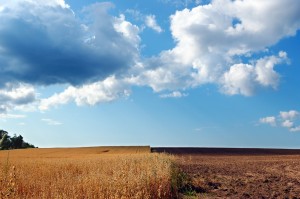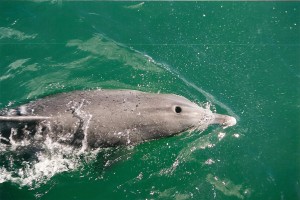Worldlog Semaine 43 -2013
Le 16 octobre on a célébré la Journée mondiale de l’alimentation. 57 jours après ‘Earth Overshoot Day’, le jour où, cette année-ci, nous avons franchi la capacité de reproduction de la terre et où nous avons, par conséquent, atteint un nouveau déficit budgétaire écologique record. Le 16 octobre, un milliard de gens souffraient de malnutrition. Non pas parce qu’il y a un manque de nourriture. La terre pourvoit aux besoins de chacun. Mais au milliard de gens affamés s’oppose un milliard de gens obèses.

Nous devons faire face à une répartition très inégale de la nourriture et à des formes de déprédation qui vont mener à court terme à de vastes manques d’eau potable, de phosphate et de biodiversité parmi d’autres. Nous devons en plus tenir compte de pénuries d’aliments pour le bétail du fait des mauvaises récoltes causées par notre négligence par rapport au climat.
Le mois dernier, des recherches de l’Université de Minnesota ont montré qu’il y a bien de l’espoir pour une population mondiale qui croît sans cesse, à condition que la manière de gouverner soit fondamentalement altérée. La superficie de terres cultivables actuelle devrait suffire pour alimenter plus de 10 milliards de personnes, à la condition qu’on s’arrête de gaspiller la production en fonction de l’alimentation du bétail et des biocarburants.
L’élevage occupe mondialement 80% de toutes les terres arables. La consommation et production excessive de protéines animales est à la base de l’obésité sévère et de la souffrance animale dans nos pays mais aussi de la faim de la destruction ailleurs dans le monde. De larges zones de forêt équatoriale se voient toujours défrichées afin de permettre la culture massive d’aliments pour le bétail. La production de la viande est ainsi responsable de 30% de la perte mondiale en biodiversité.
Une étude sur le futur de l’élevage néerlandais indique notre style de vie requière quatre globes terrestres au cas où le reste du monde copie notre modèle de consommation. Renforcer l’agriculture saine, près de chez nous, peut restaurer les cycles de matières premières, réduire notre dépendance alimentaire et fournir au monde entier un exemple durable. Une agriculture véritablement durable rétablit le lien entre le consommateur et le producteur alimentaire, et veille à ce que les paysans reçoivent un prix convenable pour un produit équitable.
Le cabinet devra faire un effort pour que les citoyens néerlandais perçoivent leurs habitudes de consommation comme une des armes les plus importantes dans la lutte contre le changement climatique, la perte en biodiversité et la souffrance animale.
Dans mon Worldlog de la semaine 40 j’ai raconté le succès qu’a eu notre tentative d’arrêter les massacres de dauphins dans les îles Féroé. Cette semaine de bonnes nouvelles nous parviennent également au sujet des dauphins au Japon. Notre motion qui appelle le gouvernement néerlandais à s’opposer au niveau international afin de faire cesser les tueries de masse annuelles de dauphins auprès de Taiji (Japon), a été approuvée!
Toutes les années des milliers de dauphins sauvages sont traqués auprès de Taiji (et des îles Féroé) pour ensuite les mettre à mort d’une façon cruelle, laissant derrière eux une mer de sang. Le Japon a une part importante dans ces chasses pour pouvoir vendre pour beaucoup d’argent les dauphins au delphinariums, aquariums et programmes touristiques où l’on peut nager avec ces animaux. Le reste des dauphins, quelque 23.000 par année, sont abattus pour leur viande.

La chasse commerciale sur les baleines est illégale mais les petits cétacés dont les dauphins ne figurent toujours pas dans la liste Internationale pour la protection des baleines. Notre motion veut que le gouvernement s’engage pour que la protection de ces espèces soient élargie pour aussi éviter la chasse sur les petits cétacés.
Cliquez ici pour le trailer du nouveau film the Blackfish, un vrai must see!
Et regardez ici ou lisez ici pour plus d’info sur l’action magnifique de l’artiste Banksy: Sirens of the Lambs!
A la semaine prochaine!
On 16 October it was World Food Day. 57 Days after Earth Overshoot Day, the day on which we exceeded the reproductive capacity of the earth this year and hit a new record ecological budget deficit. On 16 October one billion people went to bed with hunger. People are not hungry because too little food is produced. The earth offers enough for everyone’s needs. But next to those one billion hungry people are one billion people who suffer overweight.

We contend with a distorted division of food and forms of exhaustion, which, in our generation, will lead to scarcity of drinking water, phosphate and biodiversity among other things. Furthermore, we have to watch out for a possible shortage of cattle food due to poor harvests as a result of the neglect of our climate.
Research of the University of Minnesota showed us last month that there is definitely hope for a growing world population, on the condition that the policy will be substantially changed. With the current arable farming area we should be able to feed more than 10 billion people, provided that we do not waste harvests on cattle food and biofuel.
Cattle farming on a global basis takes up 80% of all agricultural lands. The excessive animal protein consumption and production do not only cause serious overweight and animal suffering here, but also hunger and destruction in the rest of the world. The tropical rain forest is still cut down on a large scale for the massive production of cattle food. As a result, the production of meat is accountable for 30% of the global biodiversity loss.
A study into the future of Dutch animal husbandry indicates that we would need four globes to fit our lifestyle when the rest of the world takes over our consumption pattern. Aiming for healthy agriculture, close to home, may close the raw materials cycle again, reduce our food dependency and give the world an example of good sustainability. A true sustainable agriculture will repair the connection between the consumer and the food producer and will ensure that farmers get a fair price for a fair product.
The government will have to encourage the Netherlands to consider knife and fork as the most important weapons in the fight against climate change, biodiversity loss and animal suffering.
In my Worldlog of week 40 I told you about the successful stopping of dolphin slaughter on the Faroe Islands. This week we also have some good news for the dolphins in Japan. Our motion, which calls the Dutch government to advocate internationally for an end to the annual mass slaughter of dolphins at Taiji (Japan), was adopted!
Each year thousands of wild dolphins are driven together at Taiji (and the Faro Islands). The animals are killed in a barbaric way, resulting in one big bloodbath. Japan has a great share in these drives, so that they can sell wild dolphins for a lot of money to dolphinariums, sea aquariums and touristic programmes for swimming with these animals. The other dolphins, approx. 23,000 dolphins per year, are slaughtered for their meat.

Commercial hunting of whales is illegal, but small cetaceans, including dolphins, have still not been included in the protection programme of the International Whale Commission (IWC). Thanks to our adopted motion the government now has to aim at expansion of the protection regime of the IWC, so that the hunting of small cetaceans can also be tackled.
Click here for the trailer of the new film of the Blackfish. This film is highly recommended!
And look here or read here about the wonderful action of artist Banksy: Sirens of the Lambs!
Until next week!